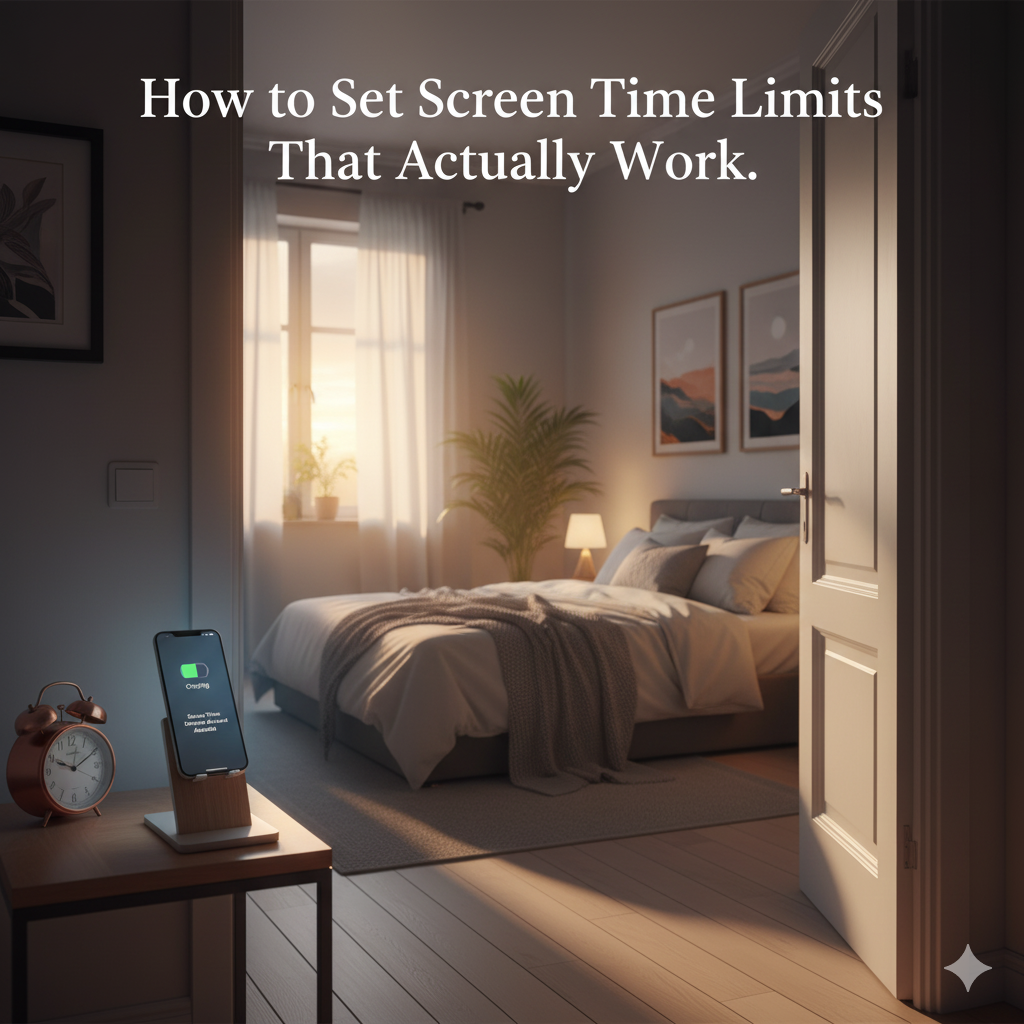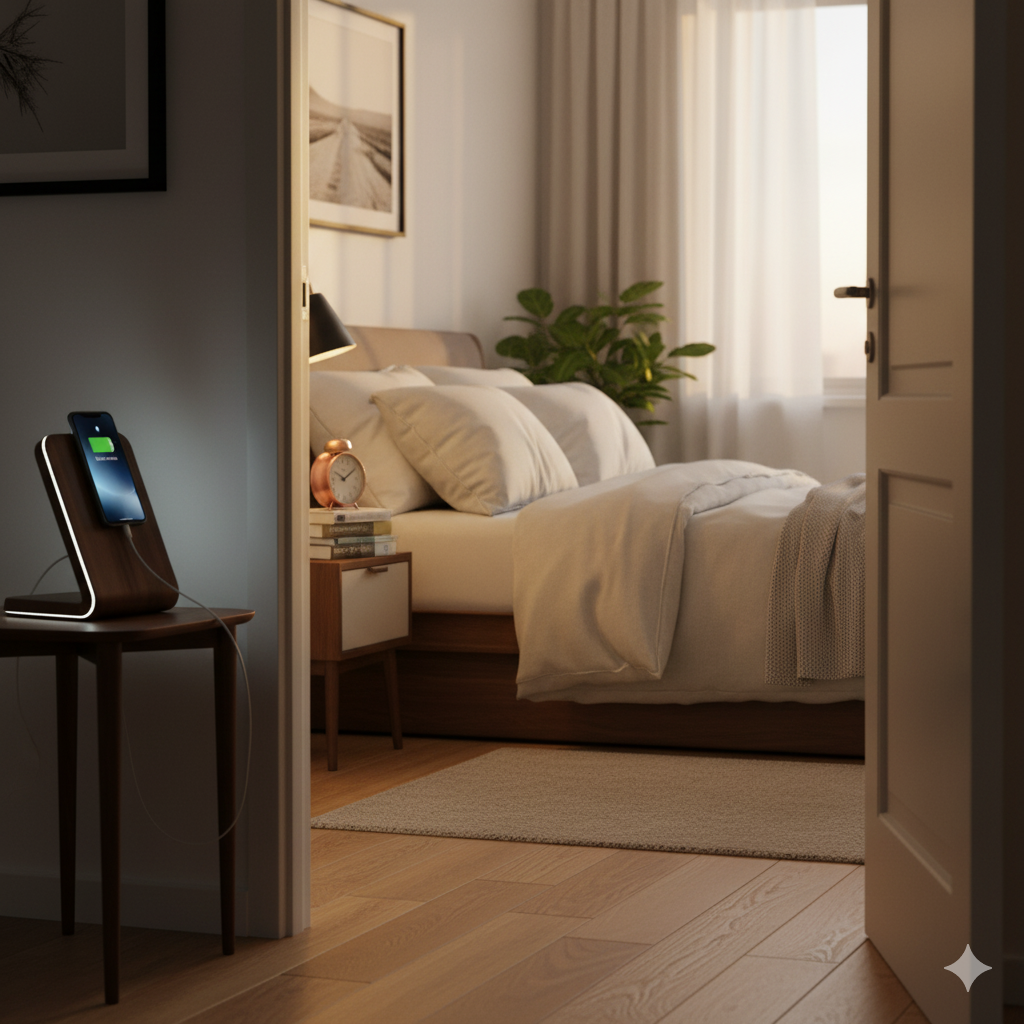Ever picked up your phone for “just a second” and an hour later you’re still scrolling, wondering where the time went? You’re not alone. In our hyper-connected world, our devices are designed to keep us hooked, often leaving us feeling drained, distracted, and guilty.
The idea of setting screen time limits might sound… well, restrictive. Like being grounded from your favorite apps. But what if I told you it’s actually the opposite? What if setting smart boundaries is the key to true digital freedom, giving you back your precious time, focus, and peace of mind?
Welcome to your 7-Step Freedom Plan for how to set screen time limits that actually work – not by making you feel deprived, but by empowering you to use technology intentionally. This guide is for anyone who wants to reclaim their life from endless scrolling and build a healthier, happier relationship with their digital devices.

The Screen Time Trap: Why We Need Limits
Our smartphones and computers are incredible tools, but their always-on nature can turn them into silent saboteurs of our well-being. Here’s why setting limits isn’t just a good idea, it’s essential:
- Dopamine Driven Design: Apps are engineered to trigger dopamine releases, creating addictive feedback loops. Likes, notifications, and endless feeds keep us coming back for more.
- Attention Erosion: Constant notifications and multi-tasking fragment our attention, making deep focus difficult and impacting our ability to concentrate in the real world.
- Mental Fatigue & Burnout: Our brains are not meant for constant digital stimulation. This leads to brain fog, decision fatigue, and increased stress and anxiety.
- Sleep Disruption: Blue light emitted from screens suppresses melatonin, making it harder to fall asleep and reducing sleep quality.
- Time Vampire: Mindless scrolling devours hours that could be spent on hobbies, relationships, personal growth, or simply resting.
- FOMO & Comparison: Social media often presents a curated, unrealistic view of life, leading to feelings of inadequacy, jealousy, and social anxiety.
If you’ve ever felt any of these, you’re experiencing the symptoms of an unchecked digital life. But don’t despair – freedom is within reach!
The Mindset Shift: From Restriction to Empowerment
The key to how to set screen time limits that actually work is to change your perspective. It’s not about being restricted; it’s about being liberated.
- You’re in Control: You’re not being told what to do; you’re choosing what’s best for your well-being.
- More Time for What Matters: By limiting distracting screen time, you create space for activities that truly enrich your life.
- Enhanced Focus: With fewer digital interruptions, your concentration improves, making you more productive and present.
- Better Mood & Sleep: Reducing digital overload leads to less anxiety, more restful sleep, and an overall happier disposition.
Ready to take charge? Let’s dive into your 7-step freedom plan!
Step 1: The Honest Audit – Know Your Digital Habits
Before you can set effective limits, you need to understand your current screen time landscape. This step is about awareness, not judgment.
Action Plan:
- Track Your Screen Time: Most smartphones have built-in screen time trackers (e.g., “Screen Time” on iOS, “Digital Wellbeing” on Android). If not, consider a third-party app like QualityTime or RescueTime. Track for at least 3-7 days.
- Identify Your “Time Sink” Apps: Which apps are consuming the most of your time? Social media, streaming, games, news, email? Be specific.
- Note Your Triggers: When and why do you reach for your device? Is it boredom, stress, a specific notification, while waiting, first thing in the morning, or before bed?
- Assess Your Feelings: How do you feel before, during, and after using these apps? Energized, happy, anxious, guilty, tired, or restless?
Insight: This audit often provides a startling reality check. This data is your foundation for informed decision-making.
Step 2: Define Your “Why” – Connect to Your Deeper Goals
Limits are easier to maintain when they’re tied to something meaningful. What do you want more of in your life?
Action Plan:
- List Your Values: What’s truly important to you? (e.g., family, health, creativity, learning, peace, productivity).
- Envision Your Ideal Day: How would you spend your time if you weren’t constantly distracted by screens? What activities would you engage in? How would you feel?
- Link Limits to Gains: Instead of “I’m limiting Instagram to 30 mins,” think “I’m limiting Instagram to 30 mins so I have more time to read, work on my creative project, or connect with my partner.”
- Write It Down: Post your “Why” where you’ll see it (e.g., as a phone background, on your mirror).
Insight: Your “Why” provides motivation and reminds you that setting limits isn’t about giving something up, but gaining something far more valuable.
Step 3: Implement Strategic App Limits – Use Your Phone’s Tools
Your phone is smart, so use its features to your advantage! Most modern smartphones offer robust screen time management tools.
Action Plan:
- Set Daily App Limits: Go into your phone’s settings (Screen Time for iOS, Digital Wellbeing for Android) and set daily time limits for your most distracting apps. Start with a realistic goal, perhaps cutting your current usage by 20-30%.
- Example: If you spend 2 hours on Instagram, set a 1.5-hour limit.
- Utilize Downtime/Focus Modes: Schedule periods where only essential apps (or no apps) are allowed. This is great for work blocks, evenings, or during family time.
- Consider App Blocking Apps: If you need extra support, third-party apps like Freedom, AppBlock, or Cold Turkey can block websites and apps across all your devices during designated times.
- Gray Scale Mode: Try turning your phone screen to grayscale. Studies show that colors make apps more appealing. Reducing saturation can make them less captivating.
Insight: These tools provide a gentle nudge or a firm barrier, helping you stick to your intentions without constant willpower.
Step 4: Declutter Your Digital Environment – Out of Sight, Out of Mind
A minimalist digital space reduces temptation and makes mindful use easier.
Action Plan:
- Notification Overhaul: This is huge! Turn off all non-essential notifications for every app. Only allow notifications for direct communication from key people (e.g., calls, texts from family). Turn off badges, banners, and sounds for everything else.
- Why it works: Eliminates the constant “pull” that leads to compulsive checking.
- Homescreen Minimalism: Only keep essential, productive apps on your main home screen. Move distracting apps into folders on a secondary screen, or even off the home screen entirely.
- Delete Unused Apps: If you haven’t used an app in a month, or if it consistently makes you feel bad or waste time, delete it. You can always re-download if truly needed.
- Unfollow & Unsubscribe: Ruthlessly curate your social media feeds and email subscriptions. Unfollow accounts that don’t inspire, educate, or positively entertain you. Unsubscribe from newsletters you never read.
Insight: By reducing the visual and auditory cues, you make your digital environment less addictive and more conducive to focus.
Step 5: Create “Unplugged Zones & Times” – Physical & Temporal Boundaries
Sometimes the best limit is a complete break. Designate specific times and places where tech simply isn’t allowed.
Action Plan:
- Bedroom Ban: Charge your phone outside your bedroom. Use an old-fashioned alarm clock. This is one of the most powerful steps for better sleep and reduced morning anxiety.Image of
- Mealtime Mindfulness: Declare meal times (alone or with others) tech-free. Focus on your food and conversation.
- “First & Last Hour” Rule: Avoid screens for the first hour after waking up and the last hour before going to bed. Use this time for analog activities.
- Designate Tech-Free Blocks: Schedule specific hours in your day or even a full day each week where you intentionally go offline from non-essential tech.
Insight: Physical and temporal boundaries create clear separation, making it easier to disconnect without constantly feeling the urge to check.

Step 6: Fill the Void with Analog Activities – Replace, Don’t Just Remove
Simply removing screen time without replacing it with something else can lead to feeling restricted or bored. This is where the magic happens!
Action Plan:
- Rediscover Hobbies: What did you love to do before constant digital distractions? Reading, painting, gardening, cooking, playing an instrument, journaling, crafting?
- Spend Time in Nature: Go for walks, hikes, or simply sit in a park. Nature has a profound calming and restorative effect.
- Connect In-Person: Schedule face-to-face time with friends and family. Engage in activities together that don’t involve screens.
- Learn Something New: Take an online course (on a laptop, not your phone, during a designated time), pick up a language, or delve into a subject you’re curious about.
- Practice Mindfulness: Try meditation, yoga, or simply sitting in silence for a few minutes each day.
Insight: Replacing digital habits with enriching analog activities is key to sustainable change and feeling truly liberated, not restricted.
Step 7: Practice Patience, Flexibility & Self-Compassion – It’s a Journey!
Setting screen time limits isn’t a one-and-done event. It’s an ongoing process of learning and adjustment.
Action Plan:
- Start Small: Don’t try to overhaul everything at once. Pick one or two steps and master them before moving on.
- Expect Slip-Ups: You’re human! There will be days when you exceed your limits. Don’t beat yourself up. Acknowledge it, learn from it, and gently reset for the next day.
- Adjust as Needed: Your needs will change. If a limit feels too strict or too lenient, adjust it. This is your plan.
- Focus on Progress, Not Perfection: Celebrate small victories! Every time you choose an analog activity over scrolling, that’s a win.
- Find a Support System: Share your goals with a friend or family member who can offer encouragement and accountability.
Insight: This journey is about building new, healthier habits. Be kind to yourself, stay consistent, and remember your “Why.”
Conclusion: Your Freedom Awaits
Learning how to set screen time limits that actually work is one of the most empowering acts of self-care you can undertake in the digital age. It’s not about deprivation; it’s about intelligent design – designing a life where technology serves you, rather than controls you.
By implementing these 7 steps, you’re not just cutting down on screen time; you’re actively choosing more focus, deeper connections, better sleep, reduced stress, and ultimately, a richer, more present life. You’re reclaiming your time, energy, and inner peace, one intentional choice at a time.
Ready to break free from the scroll and take control of your digital life? Pick one step from this guide that excites you most and commit to trying it today. Then, come back and share your experience in the comments below! What’s your first step towards digital freedom?
Want more expert advice on building a balanced digital life? Subscribe to the Unplugged Routine newsletter for exclusive strategies, tips, and inspiration delivered straight to your inbox!